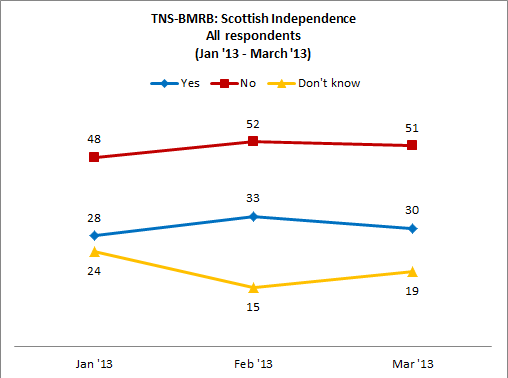Today, pollster TNS-BMRB publishes its most recent poll on Scottish independence. Often as not, today's results are quoted in isolation. I thought it might be helpful and of interest to stage a beneath-the-topline retrospective on the company's findings since the start of 2013. One wee note of caution. In January, TNS BMRB was still using the old formulation about negotiating independence, adopting the Scottish Government's new question first only in February. The impact of the change seems negligible, so I've simply included the January figures in the charts below.
I don't have much time to commit to the exegesis of this material, so today I'll mostly be presenting the data, and leaving it at that, with a couple of marginal notions, to aid understanding. Today's data is labelled as March '13 throughout. First up, TNS-BMRB's findings on the changing overall picture since January.
Gender
Historically, the gender gap has remained a stubborn feature of independence polling. Interestingly, TNS-BMRB has consistently generated smaller discrepancies between the voting intentions of men and women in the referendum than many of its competitors.
Age
Polling data on the breakdown of voting intentions by age has been marked by significant volatility at the bottom, most youthful end of the spectrum, and a good deal of solidity as we approach the eldest cohort of respondents. Opposition to independence amongst those aged over 55 continues, undented. By contrast, the sometimes more-pro-independence younger voters continues to leap about like a frog in a frying-pan.
35 - 54
55 - 65+
Social Grading
Like a number of other pollsters, TNS BMRB break down their data using "social grading" codes. Respondents are classified based on the occupation of the "head of household". This information on the chief earner's profession is broken down into AB (upper) and C1 (lower) middle classes, with C2 representing the "skilled working class", and DE denoting the working class and those living at the lowest levels of subsistence. To add a bit of important context, according to Ipsos-MORI, something like 27% of Britons would be classified as of AB social grade, 29% as C1s, 21% as C2s, and 23% as DE.
Previous polls have tended to show that opposition to independence is substantially higher amongst AB voters than their poorest fellows. While TNS-BMRB found that opposition to independence is 8% down amongst AB voters than at the start of the year, today's poll shows a spike in the number of the poorest Scots who oppose the measure, and an independence droop. That said, the poorest cohort of Scots remains the most supportive, while the richest remain unconvinced, with less a quarter of AB voters currently favouring independence.
Independence: AB and C1s.
Independence: C2DEs.







No comments :
Post a Comment